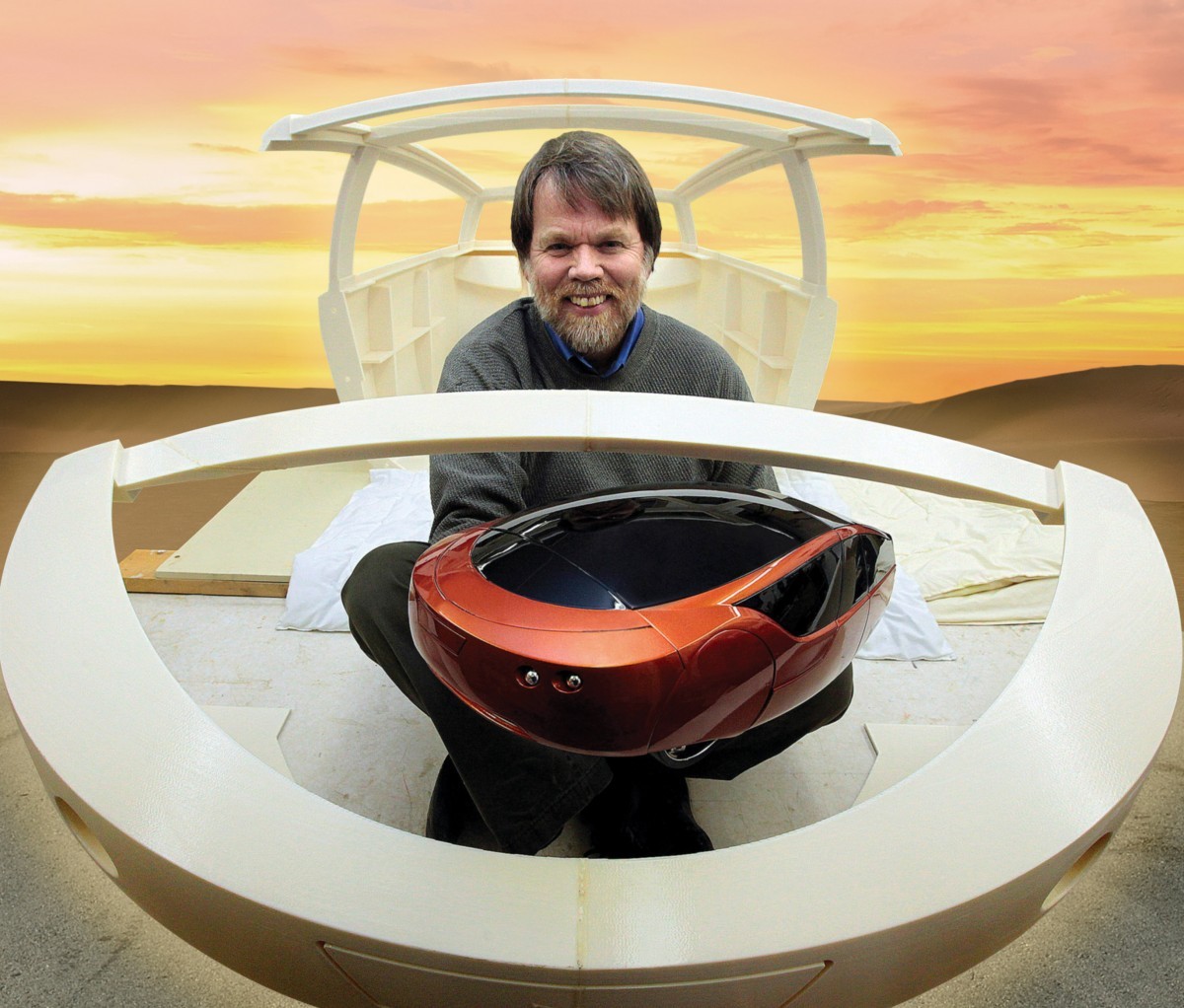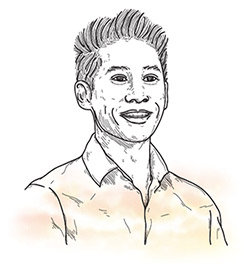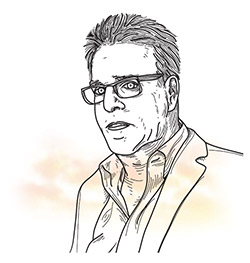To discuss the car of the future, Jim Kor [BSc(ME)/74] rolls up in a ‘64 Chevy.
The enthusiastic engineer—equal parts green technology genius and likeable handyman—is on the cusp of transforming the auto industry with the development of the Urbee (URBan Electric with Ethanol).
The hybrid car, once called a poor man’s Tesla, uses electric power in the city and an internal combustion engine powered by renewable bio-fuel on the highway. And here’s something cool: about 60 per cent of the car is created by additive manufacturing, also known as 3-D printing.
“It’s liberating because anything you can imagine as a designer can be built with 3-D printing. It will likely change the face of manufacturing,” Kor says.
Printing a replacement part after a fender bender is tantalizing, but Kor and the KorEcologic team—a dozen designers and engineers with a green bent—are less focused on the Urbee’s 3-D-printed interior and exterior and more on its sustainability, which they believe could disrupt the automobile industry.
The end-goal of the Urbee is to make cars long-term, energy-efficient investments and to make renewable resources mainstream, which the KorEcologic team believes is “vital to the survival of our civilization.”
The media, however, have been much more interested in the car’s 3-D printing component.
“But how do you flip that publicity into funding?” Kor says with a shrug. “It’s difficult to market sustainable choices.”
Especially when those choices require a shift in expectations from today’s drivers. For example, Kor says his team is choosing to design a slower car. It’ll keep up with traffic, but won’t win you any races. A small price to pay for a car designed to save money and, as an added bonus, save the planet.
Another problem with current car culture, says Kor, is the ever-increasing automation of vehicles—cruise control, park assist, rear-view cameras and sensors, to name just a few features designed to make driving easier. Problem is, each of these components can break down and be costly to replace, making the car more disposable.
Which takes us back to the ’64 Chevy. For a do-it-yourselfer like Kor, society’s emphasis on convenience, automation and bigger, better, faster, can be frustrating.
“Sometimes I think humanity is in its adolescence. If it’s possible, we want it. Even if it’s not good for us. We don’t know how to say no yet.”
Big Data and Big Likes
“You want to do something innovative and useful for people. I mean, you want to change the world.”
At Facebook, “no” doesn’t get many likes.
With 1.5 billion users (five new profiles are created every second) and a market value of $323 billion, Facebook has the resources and big data to bring the theoretical world of artificial intelligence (AI) into the everyday reality of urban teenagers, third-world entrepreneurs and all those in between.
AI works by taking the information we create every day on our connected devices, generating insights into our behaviours, and distilling it down to intelligent guesses on our wants and needs.
Ever been amazed (or perhaps spooked) by Facebook’s ability to guess—know?—exactly what you’re searching for before you can even finish typing? That’s AI. Listening. Learning. Assisting.
“We’re working on cutting-edge artificial intelligence here,” says Vincent Cheung [BSc(CompE)/03], a key member of Facebook’s Applied Machine Learning team since March 2014. He works under Yann Lecun, arguably the most important AI mind on the planet. “We’re blazing a trail, figuring out how to make it useful for people who use Facebook.”
An example is Facebook’s new recognition technology that looks at photos and verbally describes them—including who, what and where—for the visually impaired. It’s smart and accurate and has received high-fives for its accessibility and inclusivity, which is a big deal for a company whose mission is to connect the world.
The social media giant has also launched a chatbot—software that mimics human conversation—that promises to transform online shopping. With it you can use Facebook Messenger to communicate directly with a store to order products instead of having to visit its website. Consider that technology applied to developing countries where people rely more on mobile phones because they don’t have the means for desktop computers. This chatbot has the potential to upend commerce by exponentially expanding access to goods and services.
“You want to do something innovative and useful for people. Something ubiquitous,” says Cheung. “I mean, you want to change the world.”
Cheung started his journey to change the world in Winnipeg, where he spent the Saturdays of his childhood at his parents’ computer store, MicroAge. He applied to the U of M’s computer engineering program—simply because he heard it was more difficult than computer science—and made his mark. Cheung’s undergrad thesis on neural networks, with advisor Witold Kinsner, led to graduation with a 4.49 GPA and a Governor General’s Medal for Academic Excellence. It also put him directly on the path of deep learning and artificial intelligence.
“You need to be focused when you’re doing your work, but not so much that you’re not aware. It’s about seeing an opportunity that was there all along that nobody else happened to notice,” he says.
Such as the algorithm Cheung developed in 2007 to easily arrange photos into collages of various shapes. He left the application available on his website, where it received little attention until a blogger from India mentioned it.
“Suddenly I had 20,000 downloads in one day. That’s when I realized people had been touched by something I created and had been impacted by my work,” Cheung says. “It was a huge turning point.”
Since then, Shape Collage has been downloaded 10 million times and generates seven-figure returns. Even better? It brought Cheung to Facebook, where he says he got his dream job.
“Everyone’s fearful of new technology,” Cheung muses, enjoying sunny skies through the enormous windows at Facebook’s headquarters in Menlo Park, CA. “They thought cars would destroy society, TVs would rot brains. They said computers would automate everything and there’d be no jobs. Obviously it’s not true. Every time, new technology creates jobs and opportunities.”
AI for Everyone
“We’re transforming the planet with this technology, and the rate and pace has been remarkable.”
Dr. Michael Karasick [BSc(Hons)/81] is the vice-president of cognitive computing at IBM, which he joined in 1988. He. Is. Smart. Phrases like “solution pattern” and “radio frequency ID system” fall out of his mouth faster than they can be Googled.
Part of Karasick’s portfolio is Watson. You may recall the supercomputer’s appearance on the game show Jeopardy in 2011, in which it thumped the show’s most winning contestant, Ken Jennings. “Watson has been an interesting ride, because it’s much more than question and answer technology now. We’ve packaged pieces of this esoteric AI technology into cognitive services in the Cloud. If you can create a web page, you can build a Watson in a few hours to do interesting things for you,” he says.
Since Watson’s appearance on Jeopardy, its technology has been integrated into almost 20 different industries around the globe. In Bangkok, Thailand, Watson is used to interact with cancer patients. An application in Melbourne, Australia helps students navigate a campus.
Watson is rising to the challenges of Japan’s shifting demographics by helping the elderly care for themselves.
“In this work, you often get stuck in the minutiae of day-to-day. But when you hear about technology helping to treat people, to improve lives, that’s humbling,” says Karasick.
He had a front-row seat for such transformational change when he led an IBM team in Beijing, China for three years.
“It was participating in the emergence of a middle class. Watching wealth being created by people who didn’t expect it in their lifetimes, by technology they’d never envisioned before. That was really incredible. The highlight of my career, definitely,” says Karasick.
In much the same way technology disrupted the status quo in Beijing, IBM’s democratization of AI, by offering Watson software as a pay-as-you-go service, is changing the game.
“Every so often someone uses our technology to do something you didn’t consider and you’re amazed,” says Karasick.
A truly exciting development, and the next stage in AI, he says, is computational creativity.
“We think computers run numbers and cars; they don’t create art, poetry and food,” says Karasick. “Well, we have a computer scientist who’s also a published poet. He created a Watson application to create haiku. I was blown away. This is about analysing meaning and the expressivity of language. You don’t think of computers as able to do that with inherent aesthetic appeal. That’s a surprise, that’s profound.”
Chef Watson is another surprising application; it processes your culinary preferences and the contents of your fridge to create an original recipe. IBM fed the computer Bon Appétit magazine’s recipe database, nutritional information from the USDA and Wikipedia entries about world cuisines and their typical ingredients. Chef Watson then made its debut with a food truck at the 2014 SXSW festival in Austin, Texas and had lineups around the block, feeding music fans snacks like Austrian chocolate burritos and Belgian bacon pudding.
“We’re transforming the planet with this technology, and the rate and pace has been remarkable. I’m privileged to take part in it, I really believe that. It’s an honour,” says Karasick. “It’s the beginning of an interesting journey for me and for all of us.”
Tradition meets Innovation
“Sometimes the best solutions are a new way of thinking applied to the way things were.”
Meanwhile, Jim Kor is planning his own journey.
To highlight the Urbee’s incredible fuel-efficiency, Kor is planning a record-setting, cross-America trip in 2018 for his two sons and a dog using only 10 gallons of bio-fuel. He’s mimicking the historic first cross-country car trip in 1903 by automobile pioneer Horatio Jackson.
While infrastructure was the challenge for Jackson, Kor says the challenge today is funding. So far the Urbee has been largely self-funded; now he needs $3 million to complete the prototype and accomplish the record run. He’s approached a like-minded company for sponsorship and remains hopeful that the Urbee will see its first production run by 2022.
“Tradition limits solutions and innovation opens doors, but our process is usually rooted in a return to fundamentals,” says Kor, explaining the delicate balance required when attempting a hard left on technology. “Sometimes the best solutions are a new way of thinking applied to the way things were.”
And so it goes. Perhaps, then, the person with the crescent wrench in their backpack is the greatest disruptor of them all.









